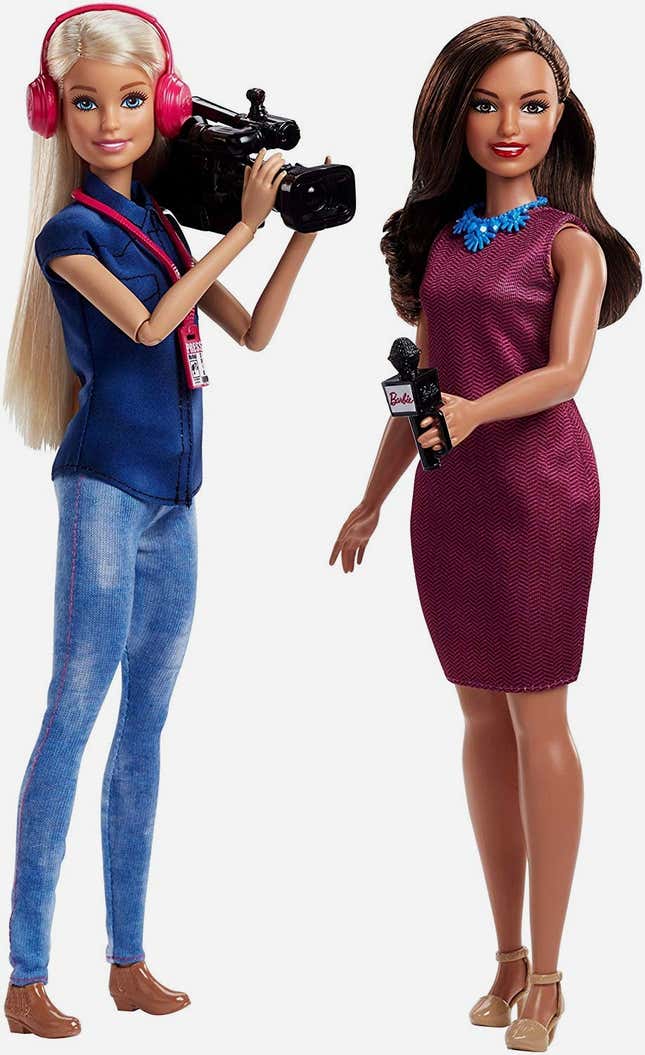My mom did not want me to play with Barbie. Her ban lasted until I was 6 and I talked my grandmother into buying me one. Her name was Malibu Barbie, and she came clad only in a mauve one-piece bathing suit, so I spent the next several weeks fashioning elaborate gowns for her out of toilet paper and fabric scraps. By the time I was 10, my two sisters and I had several dozen Barbies between us, and a tiny department store’s worth of clothing for them.
As a mother myself now, I see where my mom was coming from. The idea of little girls idealizing Barbie’s stiletto-ready feet, synthetic blonde hair, and cone-shaped breasts—crudely exaggerated like a blow-up doll—is somewhat horrifying. Barbie doesn’t feel like a model of womanhood so much as an almost random representation of one person’s fetish for wasp-waisted blondes. That’s an adult perception though, and not at all how I experienced her as a child.
There’s a widespread belief that playing with Barbie, and her unrealistic body, hurts girls’ self esteem, and in 2016 Mattel introduced Barbies with different body shapes and sizes, in response to falling sales and consumer demand (though some pointed out that even the “curvy” Barbie was still quite thin). The research on the effect of Barbie on girl’s self-perception, however, has been sparse and inconclusive. In general, the older the girl, the greater likelihood that she is dissatisfied with her body, which points to the wealth of media emphasizing the thin idea and typical Western beauty standards, of which Barbie is just one example.
It’s impossible to say how much of Barbie’s peculiar aesthetic I internalized, but over the many hours I spent giving her mohawks and dressing her in shiny gowns and tiny high heels, I don’t remember ever wishing I looked like her. I learned to compare myself to other girls, and to the flawless women in the pages of magazines and on my television—and perhaps Barbie primed the pump for that in a way I’m not able to consciously process.
I find that idea a little condescending to girls though. It says that we can’t differentiate between our own flesh-and-blood bodies, that pedaled bicycles, jumped into swimming pools, and licked ice cream cones, in addition to playing with Barbie, a plastic doll. I give my 10-year-old self more credit than that.
And I think it overlooks the way Barbie was and is a blank slate for children’s hopes, ambitions, and aspirations. In the 60 years since she was introduced as a “teenage fashion model,” Barbie has been an astronaut, a veterinarian, a babysitter, and a beekeeper. Depending on what doll you’re talking about, Barbie could be anything from a rich teen pop star to a working class adult. She has worn saris, South African neck rings, and cheongsams. She has no specific age or race, no discernibly distinct personality. And this blankness is her greatest asset.
Yes, Barbie’s blankness, and her huge stockpile of accessories, reflects back consumer culture to the girls who play with her. And yes, her improbable figure mirrors our cultural obsession with the shape of women’s bodies. But that very lack of specific personality also leaves her open to interpretation, for the immeasurable power of girls to imagine many different ways of being.
Barbie, the original “influencer,” was also a proxy for girls’ imaginations and aspirations. Whether she dons a ballgown or a power suit, whether she drives a scooter or a food truck, she is the most democratic of dolls. When she was introduced in 1959 she cost $3, or about $26 today. Modern Barbies are less expensive—most start at around $15, and you can get chicken farmer Barbie with a playset for $17, or a two-pack of a reporter and camerawoman $19, for your budding investigative journalist. For comparison, the aggressively wholesome American Girl doll is vastly more expensive, running well over $100 each.

The one thing that Barbie has never been is a mom (though there was that one disastrous and creepy pregnant Midge doll, which Mattel discontinued after critics claimed that it promoted teen pregnancy). This is likely because of Barbie’s strange agelessness—she can always be viewed as a teenager, though many of her iterations suggest that she is a fully grown woman who has been to college and has a career (see: paleontologist Barbie, robotics engineer Barbie, and Mars Explorer Barbie).
This may seem like a small detail, but in retrospect I appreciate it. As a young girl I was surrounded by toys that were a proxy for motherhood. I remember laying in bed at about age seven, feeling guilty that I hadn’t spent enough time with my Cabbage Patch doll that week. I never felt guilty about Barbie—she could take care of herself. My sisters and our friends spent hours creating narratives around our Barbies, where they worked, where they lived. We made them into everything from rock stars to Little House on the Prairie-style pioneers.
So yes, I understand my mother’s reticence about bringing Barbie into a house full of girls. But Barbie didn’t do the damage she feared. She may have strode in, in her mauve bathing suit, as a hated symbol of the limitations of being a girl—but she ended up being a tool for imagining the infinite possibilities of the adult lives ahead of us.
